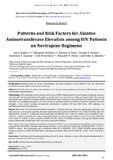| dc.contributor.author | Makori, Jones | |
| dc.contributor.author | Ambetsa, Margaret | |
| dc.contributor.author | Sinei, Kipruto A | |
| dc.contributor.author | Osanjo, George O. | |
| dc.contributor.author | Guantai, Anastasia N. | |
| dc.contributor.author | McClelland, Scott | |
| dc.contributor.author | Oluka, Margaret N | |
| dc.date.accessioned | 2015-11-30T10:12:40Z | |
| dc.date.available | 2015-11-30T10:12:40Z | |
| dc.date.issued | 2015 | |
| dc.identifier.citation | Makori, J., Ambetsa, M., Sinei, K. A., Osanjo, G. O., Guantai, A. N., McClelland, S., ... & Okalebo, F. A. (2015). Patterns and Risk Factors for Alanine Aminotransferase Elevation among HIV Patients on Nevirapine Regimens. African Journal of Pharmacology and Therapeutics Vol, 4(2), 59-66. | en_US |
| dc.identifier.uri | http://hdl.handle.net/11295/92706 | |
| dc.description.abstract | Background: Elevated levels of serum transaminases are often detected in HIV patients. This has often been
attributed to hepatic effects of antiretroviral drugs.
Objective: To determine the pattern and risk factors for alanine aminotransferase elevation in HIV patients positive
on nevirapine based regimens.
Methodology: We conducted a retrospective cohort study of HIV infected patients on nevirapine containing regimens
who attended the Kenyatta National Hospital comprehensive care clinic between May and August 2014. We sampled
participants by convenient sampling method. Generalized linear regression was performed to establish patterns and
predictors for hepatotoxicity (grade 1-4) which were the primary outcomes of interest. Predictor variables that were
included in the analysis include; demographic information, baseline ALT and CD4 levels, ART regimens, comorbidities
and treatment duration.
Results: Risk factors for ALT elevation differed by gender. Predictor variables that were significantly associated with
ALT elevation in both sexes included; elevated baseline ALT level [β=10.14 (95%CI 7.34- 12.96); P<0.001], [β=13.52
(95%CI 9.36 –17.68); P < 0.001] and renal disease [β=5.44 (95%CI 2.62 – 8.25); P <0.001], [β=11.52 (95%CI 3.46 –
19.60); P = 0.005] in females and males respectively. Ethnicity had a protective effect in both sexes; [β-6.61(95%CI-
9.28, -3.93); P< 0.001] in males and [β-1.20 (95% CI-2.39, -0.01); P= 0.048] in females. Among the different ethnic
groups, Nilotes and Cushites had lower ALT levels compared to Bantus.
Other factors that were significant included; smoking (P=0.001), concurrent illnesses (P=0.045), previous adverse
drug reactions (P=0.040) in females and a longer duration of anti-retroviral therapy [β 1.81(95%CI 0.89 – 2.73); P <
0.001] in males. Poor adherence had a protective effect [β -1.62(95%CI -3.20, -0.04); P=0.045] among females,
whereas initiation on AZT+3TC+NVP had a significant protective effect [β-7.80 (95%CI -13.96, -1.63); P=0.013] in
males.
Conclusion: Creatinine and transaminase testing should be done routinely to deal with delayed hepatotoxicity in
patients with abnormal ALT baseline levels. | en_US |
| dc.language.iso | en | en_US |
| dc.publisher | University of Nairobi | en_US |
| dc.subject | Alanine aminotransferase, hepatotoxicity, nevirapine. | en_US |
| dc.title | Patterns and Risk Factors for Alanine Aminotransferase Elevation among HIV Patients on Nevirapine Regimens | en_US |
| dc.type | Article | en_US |

